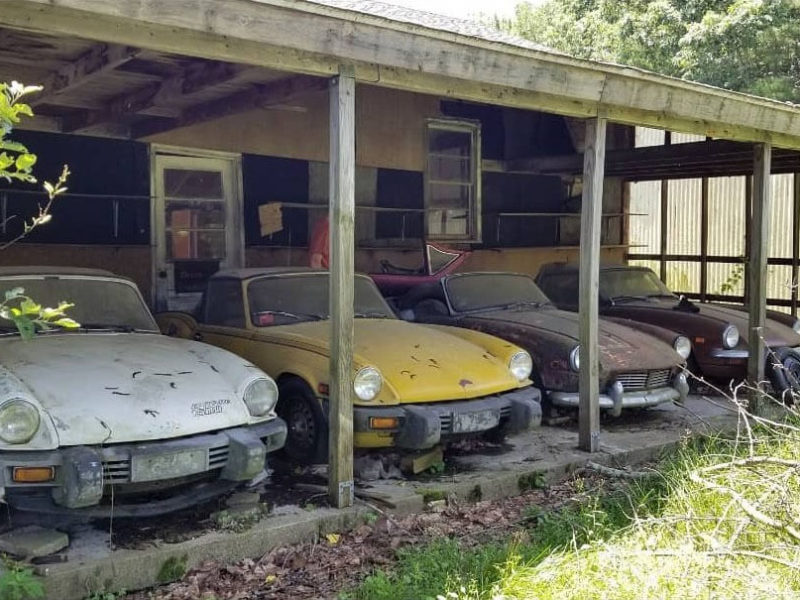(While John’s article is written for the MG owner, nearly all of his advice and information is valid for your Triumph, Austin-Healey, Jaguar and most other British cars. —Ed.)
Ask a dozen MG owners how they store their MGs and you will receive a dozen different answers. Methods range from abandoning the MG under a tree in the front yard, to complex routines involving raising the MG off the ground and removing the seats. There is not a “proper” method, as each owner has slightly different considerations and requirements—yet there are some basic rules to follow in any storage procedure that will lessen the probability of damage during storage. In addition to the normal freezing precautions, some thought must be given to location, access, traffic around the stored MG, humidity, etc. It is important to develop a plan that you can follow easily and that you can implement before winter shows its cold fury.
Basic Rules
Freezing temperatures require a 50/50 solution of antifreeze and water to prevent the coolant from freezing in the engine block, radiator, or heater. A full tank of gasoline reduces the amount of water that can be absorbed in the petrol and slows the rate at which the gasoline turns to varnish. Fresh oil in the sump reduces the etching caused by dirty, contaminated oil (which actually can become acidic). Topped off master cylinders reduce the possibility of water contamination.
Store the MG with the hood (top) up, and windows and vents closed. The folding hood (or soft top) can develop nasty creases when left folded throughout the winter. Closed vents and windows make it more difficult for small furry creatures to foul or devour parts of the MG. It’s always nice to clean the MG’s interior prior to storage—discarded bottles and cigarette butts do not enhance the interior bouquet.
Ensure that the boot (trunk) is dry. The boot seal is not always positive and some moisture can collect on the floor. Left to nature throughout the winter, this can rust the floor or inner fenders about the boot area. The underbonnet (engine-bay) is easily protected by discharging an entire can of WD-40 or similar product on all the engine components, especially the bright metal or aluminum parts (carb, coil, anti run-on valve, etc).
Finally, take the MG on the last run of the season, allowing it to heat up fully—a half hour run is wonderful. This will evaporate all the moisture in the exhaust and engine. Park the car in its winter home and leave the handbrake OFF. If you will not use the MG until spring, it’s necessary to remove the battery to prevent freezing. Should the battery burst, sulfuric acid will cover everything around the battery area. If you cover the MG, use cloth, never plastic.
Storage Considerations
Consider the following questions and make your own storage plan from these concerns:
1) Location—Will the car be stored close to home or in a barn forty miles distant? Will the MG be stored inside or outside?
2) Access—Will the car be locked in a building to which you will have little or no access to, or will it be available every day? Will it be possible to drive your car during the winter or will it be positioned in the corner of the garage?
3) Traffic—Will the car be isolated from movement, or will the family Vista Cruiser discharge four energetic, sometimes careless, children who will open doors against it?
4) Humidity—Will the storage area be very dry or will there be a puddle of melting snow forever swelling under the car?
5) Temperature—Will the storage temperatures be room temp, just above freezing, or dead cold?
6) Animals—Will the family cat use the soft top as a springboard, will Fido jump against it, are there furry rodents that may use the car as a hotel or find the leather seats tasty at mealtime?
7) Owner Maintenance—Will you really have the opportunity, inclination, time, and resolve to visit your car every week or month?
Insurance, even on your stored car, is a MUST! Always keep a theft/damage/vandalism/fire policy in effect. Cars are stolen; garages collapse under the weight of snow; nasty neighborhood children may wish to redecorate your car or worse; and fire is always a possibility. This type of insurance is very inexpensive and you simply cannot afford to be without it. Be certain to establish the value of your car with the insurance agent before the loss! In addition, make sure as well to properly maintain your garage doors to protect against thieves, as well as to keep your belongings safe. You may contact a garage door repair specialist for routine maintenance of your garage door. If it’s time to get a new, more secure garage door, contact a local garage door installer.
System Protection
1) Engine: Fresh oil is usually adequate protection for several months of relatively dry storage. If the MG is going to be stored longer, or if the humidity is high, then the engine should be started at regular intervals and allowed to warm up (with the garage door open, please). If this is not possible, introduce oil into the cylinders (perhaps six squirts from a normal oil can). Before replacing the plugs, turn the engine over slowly—by the crank in the earlier models, or pushing while in fourth gear—as this will move the oil throughout the head, pistons, and valves. Covering the tailpipe outlet with duct tape prevents moisture from entering the exhaust system, as tape over the air cleaner inlets keeps moisture from the carb internals and the cylinder head.
2) Ignition: Normally there are no preventive measures, but if the MG is going to be stored for several years, the distributor cam should be oiled.
3) Cooling: The 50/50 solution of glycol antifreeze and water is usually all the attention the cooling system receives. Some owners suggest that Armorall or a similar product can extend the life of the radiator hoses.
4) Fuel: If the MG will be in storage for just the winter, then the full tank of gasoline, perhaps with the addition of a can of “dry-gas”, will be satisfactory. If the storage will be longer than a year, then draining the float bowls to prevent a buildup of varnish would be wise. Here we have a predicament: gasoline purchased years ago seems to last forever; gasoline purchased today goes bad after a year or so, if you do leave the tank full, it may be necessary to completely drain it if the storage time is longer than a year.
5) Clutch: Two problems can occur in long term storage: the clutch hydraulics can leak: and the clutch disc can rust to the flywheel or pressure plate. Exercising the pedal on a regular basis can help these situations from happening. Damp storage is a real problem with the clutch and can aggravate this rusting. If the MG can be started, then a short fore and aft movement, using the clutch, is just super.
6) Suspension: Winter storage causes no problems with the suspension. Very few MG owners place their MGs on jacks for the winter—but if you do, place the stands under the outer portion of the front A-arms and under the leaf springs where the U-bolts surround the axle and spring. This is to keep the suspension from dropping away from the body and straining the shocks and the rebound rubbers/straps. If the MG is placed on stands, then reduce tire pressure to 10-15 lbs. Whether on stands or on the ground, be certain to move the MG once or more during storage—as little as a foot—just to keep the bearings from rusting.
7) Brakes: Rolling the MG back and forth will prevent the brake pads from rusting to the rotors (just as the clutch disc can rust to the flywheel). Pumping the brake pedal on a regular basis will keep the cylinders from freezing up. Some owners back off the adjustment on the brake drums so that there is no chance of the shoes rusting to the drums—and so that the cylinders move further while the pedal is exercised. The handbrake should be exercised, too. Rapidly working the handle up and down can prevent the cable or linkage from freezing in position.
8) Batteries: No battery will hold its charge forever. Further, when the charge of the battery is reduced far enough, the electrolyte can freeze, cracking the case and ruining the unit. If the MG is stored in freezing temperatures, then it must be started as frequently as every two weeks (at least once a month, please) or the batteries must be removed. Battery removal can be avoided by an occasional trickle charge, but the alternator should be disconnected before charging. On the 1977 and newer MGBs with the electric clock, remove the bottom fuse in the fusebox, which will stop the clock from working and eliminate that drain (albeit very small) on the electrical system. Next to the coolant in the radiator, the batteries are one of the two most important considerations in winter storage.
9) Body: To prevent oxidation or scratching, the MG should be covered with a cloth mitten. Plastic is NOT suitable. Plastic does not allow the paint to breathe, hence allowing condensation and rusting. If the MG is stored in a heavy traffic zone (the family garage, for example), then some additional protection is in order. Thick cardboard, a suitable supported piece of wood, or even an old mattress suspended from the ceiling will prevent damage from winter tools and car doors. If the bonnet or boot lid will be used for a shelf (even if just to place groceries in transit), then more protection (such as a thick blanket) is in order. Humidity is the body’s enemy. Every effort must be made to keep water from under the MG. If the storage is outside, then snow must be kept from piling up against the sides, preventing the flow of fresh air to the undercarriage. Some owners have found that by parking the MG on a large sheet of plastic, the humidity from the cement or earth does not reach the underside of the MG.
10) Interior: Extreme dryness can cause leather seats to contract and crack. It is wise to prepare the leather with a compound to keep the hide supple. If there is a chance of rodents getting into the car, they will nest in the seats, eat the carpeting, and eventually eat the insulation from the wiring! Close off access to the interior by keeping the vents and windows tightly closed and the top up. If there are small spaces through which Mr. Mouse can gain access, close them off with tape or rags. Some owners remove their seats prior to storage. A dish with mothball flakes or pellets usually dissuades the mice. Use either the old fashioned tried and tested napthelene or the new paradlchlorobenzene.
By John Twist, University Motors
Grand Rapids, Mi







'Winter Storage Tips' has no comments
Be the first to comment this post!